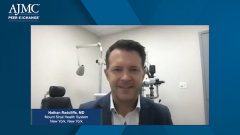
Novel Therapy in Glaucoma: Sustained Delivery Implants
A review of the novel sustained release approach with bimatoprost implants and how this is affecting glaucoma management.
Episodes in this series

Transcript:
Neil Minkoff, MD: Where in the treatment protocols, or in your treatment decision-making, are you thinking about the newly approved agent with the sustained delivery implant, and where does that fit into your treatment paradigm?
Nathan Radcliffe, MD: I’ll make a comment. I may be more enthusiastic about sustained delivery than other doctors, so take that with a grain of salt. But it solves 2 problems. It solves compliance and tolerability problems when you could just place the medicine in a patient’s eye. For me, if I have patients who don’t understand their drops or have proven on multiple visits that they are inconsistent in taking them, it’s amazing how many people ran out of their drops just the night or the day before their visit. These are patients who are probably better off to have the doctor deliver the therapy.
The Interesting thing about, in this case, we have bimatoprost [Durysta]-sustained release for injection into the anterior chamber of the eye FDA [Food and Drug Administration] approved for 1 injection, which is supposedly only lasting 4 months. It can last up to a year but probably not much longer than that, maybe 2 years in a quarter of people. It’s a temporary solution to a chronic disease. It’s not a perfect solution, but for some patients, 4, 6, 8 months, a year is longer than nothing and is still worth delivering.
In terms of coverage, interestingly, if a patient has Medicare and a commercial secondary, you can usually get it covered I’ve learned. Otherwise, there’s a PA [prior authorization] process that’s been reasonable and I can’t give it to Medicaid patients. Some frustration, some limited access, but happy to have the option. It’s better than nothing. If it’s a caregiver who’s putting the patient’s drops in and you can do a sustained therapy, you’ll get a hug from the caregiver. It can change the quality of life of people if they have loved ones at home putting in their drops.
Neil Minkoff, MD: Dr Pickering, anything to add to that?
Terri-Diann Pickering, MD: I agree with Dr Radcliffe. The sustained delivery implants are a move in the right direction. If we could get multiple drug sustained delivery implants, that would be fantastic. I could foresee even starting a patient on a trial on topical therapy to make sure they tolerate it, to make sure it’s efficacious and then putting in the implant and just removing a lot of the adherence issue. I’m sure you do, too, in New York we have a lot of patients who travel overseas. They come here for a month or 2 and then they’re gone, or they work at the university that they do field work in Iran or in Ghana. To give them some sense of mind where they may be in a place where they simply can’t get medication is huge.
Neil Minkoff, MD: Before I move on, because I do have a question about other procedures, I’d like to ask Dr Stephens and Dr Lopes about how the implant is covered and if it’s more aggressively managed than other forms of therapy.
Maria Lopes, MD, MS: First of all, is it medical or is it a pharmacy benefit? It’s likely to be a medical benefit as an implant. It does require prior authorization, as Dr Radcliffe mentioned. Many times, being on the medical benefit is a help because the copay may be a lot lower than on the pharmacy benefit where patients would pay a coinsurance and typically much higher than what they may see on the medical side. Some barriers.
We may also have frequency edits where you can’t get it any more than every 4 months, as Drs Radcliffe and Pickering have stated. It is at a much higher cost, so we look at it as a prostaglandin analogue convenience, but also we’re going to want to see some demonstrated value in terms of how the convenience is driving better adherence and better adherence is driving better IOP [intraocular pressure], and ultimately the end goal being preventing blindness. That’s going to be critical. And something payors always want to see is beyond convenience, what’s the cost of failure that we’re preventing, and real-world data that really helps us understand that.
Neil Minkoff, MD: How do you define, and maybe this is a naїve, how do you compare quantity limits for traditional medications vs something like an implant? How do you manage that? I’d be curious to hear if there are contrasting views from the payors versus the prescribers.
Maria Lopes, MD, MS: On the pharmacy side, we have quantity limits per copay. On the medical side, we have edits, frequency edits. In the case of the intracameral implant, you can’t get it any more frequent than every 4 months.
Neil Minkoff, MD: Is that a barrier to the way Dr Radcliffe and Dr Pickering try to deliver care?
Nathan Radcliffe, MD: In this case, it’s pretty reasonable. Interestingly, the 1 commercially available implant was FDA approved for 1 injection. I use it off-label and will readminister, but I’m readministering 6, 9 months, a year later. I’ve been surprised to see that I’ve been allowed to readminister and have been pleased and thought that was reasonable policy by the payor. Because they might have the option of saying, “Well, it’s only FDA approved for 1 injection.”
My oath is to the patient and, in some cases, it’s better to readminister. It’s the eye drops where the frequency limits I could see being frustrating for both physicians and for payors because I have some patients with poor dexterity who miss at least half of their drops and need 2 bottles a month. And yet, I also know that if you give the average patient twice as much as they need, they won’t come back and get an extra drop every month, and so someone suffers for that somewhere on the other side of things. I don’t have a great way to fix that problem, but it does cost some patients some vision and that’s frustrating. And that’s where we’re using samples and trying to just say, “Look, when you run out of this 1 use this 1.” It confuses patients. It’s a real struggle. I love it, the American Glaucoma Society put out a statement saying please give patients who say they miss their drops a second bottle. I’m not sure how much of an impact it had, but it is something that’s important to us.
Transcript edited for clarity.
Newsletter
Stay ahead of policy, cost, and value—subscribe to AJMC for expert insights at the intersection of clinical care and health economics.



































































